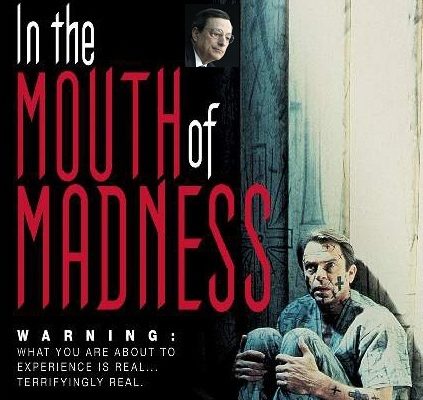The Unleashing of Madness

A number of articles have recently discussed the ECB’s quantitative easing program, which entails inter alia the buying of covered bonds. Here is a quote from an article in the Financial Times:
“The European Central Bank has started to buy covered bonds, in its latest attempt to to revive lending in the euro zone and stave off a vicious bout of economic stagnation.â€
It would be more correct to write: “ECB tries its best to revive the credit bubble that thankfully expired in 2008â€. This one sentence from the FT above encapsulates already almost everything that is wrong about these currency debasement programs. It is presented as a “given†that central bank meddling with money and credit is necessary to revive, or as it is often put, “jump-start†the economy, which is held to be mired in stagnation for generally mysterious reasons.
And yet, his comment by the FT makes as much sense as the policy, namely zero (a big, fat zero). The ECB will effectively print money, or rather, create digital money ex nihilo, to pay for these purchases. The underlying assumption that creating additional amounts of money can “stave off economic stagnation†is 180 degrees wrong. It will achieve the exact opposite, namely a structural weakening of the economy – even if, or rather, especially if, economic activity as measured by aggregated data seems to “revive†as a result.
Those who have first access to the newly created money can exercise a demand for real goods without first having contributed anything to the economy’s pool of real funding. This makes it more difficult for those people who actually do make such contributions by their productive efforts to create wealth – as they are forced to compete for a shrinking pool of real resources. As Frank Shostak explains in recent article, what happens is that “exchanges of nothing for something†result from the creation of additional money:
“Before an individual can exercise demand for goods and services, he/she must produce some other useful goods and services. Once these goods and services are produced, individuals can exercise their demand for the goods they desire. This is achieved by exchanging things that were produced for money, which in turn can be exchanged for goods that are desired. Note that money serves here as the medium of exchange — it produces absolutely nothing. It permits the exchange of something for something. Any policy that results in monetary pumping leads to an exchange of nothing for something. This amounts to a weakening of the pool of real wealth — and hence to reduced prospects for the expansion of this pool.â€
(emphasis added)
The idea forwarded by central bankers and their claque of apologists that “demand†is somehow “deficient†is utterly risible. Unless all human wants are already fully satisfied, there is a very long list of “demand†for goods and services. Surely nearly every human being in society (exceptions are perhaps the occasional hermits in mountain caves who have sworn an oath of eternal poverty and silence) has such a list of things they would like to have in his or her head. People even have demands they don’t know about yet, because the relevant goods haven’t been invented yet. Consider the nowadays ubiquitous smart phone. Before it was invented, demand for it was zero. We can undoubtedly all agree that demand for smart phones is no longer zero these days.

The ECB’s governing council on the marble steps of the monetary policy temple in Frankfurt. They are the modern-day version of the priestly classes of yore. The main difference is that their pronouncements are based on looking at “data†instead of the patterns made by chicken bones or the entrails of sacrificial animals. Unfortunately the theories on which the priests base their verdicts and decrees seem not to have evolved much.

